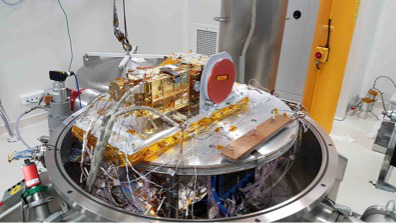Perseverance’s landing is scheduled for February 2021, in the Jezero crater. The rover will explore the geological, mineralogical and chemical remains of the lake it sheltered and the rivers that fed it. By studying these remains, Perseverance will characterize the geochemical environment that saw the birth of the lake, look for possible traces of past life and take samples that can be brought back to Earth around 2030. Mars2020 will also prepare for human exploration of Mars.

The SuperCam instrument, clearly recognizable by its "eye", will actively participate in the scientific objectives of the mission.
|The SuperCam is a Franco-Hispanic-American design and consists of three modules :
- The Mast Unit : French contribution, placed at the top of the Perseverance mast, and carried out by a consortium of French laboratories led by the Institute for Research in Astrophysics and Planetology (IRAP), and under the project management of CNES, the French space agency ;
- The Body Unit : American contribution placed in the rover body and developed by Los Alamos National Laboratory (USA) ;
- Calibration targets : provided by the scientific team and integrated by the University of Valladolid (Spain).
Of the seven instruments in the rover, SuperCam will be the only one that can take measurements beyond a perimeter of 2 metres. Its role will then be crucial in guiding Perseverance towards the rocks to be targeted for close study by the contact instruments, and from which samples will be taken.
For this purpose, SuperCam integrates several remote observation techniques :.
- A LIBS technique sprays, with a laser, the rocks in order to identify the atoms.
- A RAMAN technique excites, also with a laser, molecules and minerals to determine their nature.
- A technique analyzes reflected sunlight, from visible to infrared with two spectrometers, to characterize the mineralogy.
- A high-resolution camera (0.4 mm at 5 m) takes colour photographs of the analysed targets.
- A microphone records sounds around the rover.
By combining imaging with three spectroscopic analysis techniques, SuperCam will determine the elemental composition of the target rocks, i.e. the nature of the atoms that make them up, and the way in which they arrange and group together to form molecules and minerals.
SuperCam will characterize the nature of the rocks (sedimentary or volcanic), on a scale of a few hundred micrometers to a few millimeters ; and the conditions under which they were formed : temperature, pressure and acidity.
Thanks to its microphone and infrared spectrometer, SuperCam will also study the wind, dust and clouds in the Jezero crater ; it will contribute to understanding Martian meteorology in order to prepare and secure human exploration of the Red Planet.
**Paris Observatory - PSL in SuperCam}} In the construction of SuperCam, the Paris Observatory - PSL played a major role, through its Laboratory for Space Studies and Instrumentation in Astrophysics - LESIA.
As the scientific leader of the infrared spectrometer, LESIA provided it, with the collaboration of the Laboratory of Atmospheres, Media and Space Observations - LATMOS for the electronic cards, and the Institute of Space Astrophysics - IAS for the photometric calibration.

Compact and lightweight (less than 400 g), this infrared spectrometer will analyze the light collected by the SuperCam telescope using an acousto-optic crystal that will successively scan wavelengths in a spectral band between 1.3 µm and 2.6 µm.
It will be the first infrared spectrometer to be placed on the surface of Mars, and as such it is raising very high expectations in the Martian mineralogical community.
In addition to the project management of the infrared spectrometer, LESIA was co-responsible (in collaboration with the Bordeaux Astrophysics Laboratory - LAB) for the management of the Mast Unit ; it had full responsibility for the instrument performance (system engineering), the thermal architecture and mechanical calculations as well as the thermal test campaigns for equipment and the different models of the instrument.

For Paris Observatory - PSL, this is the second trip to Mars. If Paris Observatory is already in orbit around Mars, aboard the European space probe Mars Express since 2003, it is the first time that it will deposit an instrument of its manufacture on the Martian ground.
